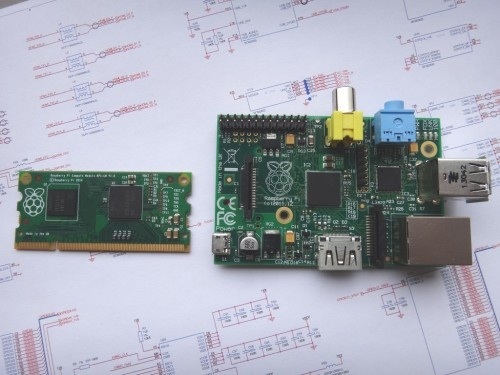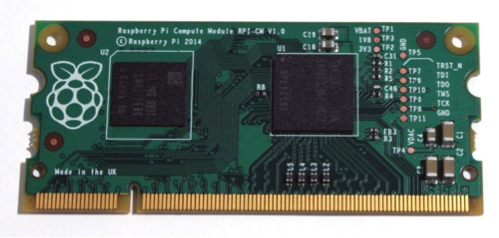 The Raspberry Pi Foundation has announced a $30 computer-on-module version of its Raspberry Pi single board computer, extending the Pi to a wider “business and industrial” market. Like other COMs, the Raspberry Pi Compute Module lacks real-world ports, but rather extends its interfaces via a standard SODIMM edge connector that plugs into a carrier board, including an “IO Board” supplied by the foundation.
The Raspberry Pi Foundation has announced a $30 computer-on-module version of its Raspberry Pi single board computer, extending the Pi to a wider “business and industrial” market. Like other COMs, the Raspberry Pi Compute Module lacks real-world ports, but rather extends its interfaces via a standard SODIMM edge connector that plugs into a carrier board, including an “IO Board” supplied by the foundation.
Starting in June, RS and Element14 will sell both the module and IO Board together as a yet-to-be-priced Raspberry Pi Compute Module Development Kit. Later this year, the module will also sell by itself for around $30 in quantities of 100 or more, and slightly higher for single units. All proceeds will be plowed back into the foundation’s educational programs.
The Raspberry Pi Compute Module measures 67.6 x 30mm, or about a third the size of the Raspberry Pi Model B. Like the SBC version, the module is built around the ARM11-based, 700MHz Broadcom BCM2835 system-on-chip with Broadcom VideoCore IV GPU, and offers 512MB of RAM. Since the module lacks an SD slot, Raspbian Linux and a bootloader are preloaded on 4GB of soldered eMMC flash.
Embedded developers making commercial products will appreciate the fact that the Pi’s entire arsenal of interfaces is readily available via the 200-pin SODIMM connector. “You get the full flexibility of the BCM2835 SoC (which means that many more GPIOs and interfaces are available as compared to the Raspberry Pi),” writes James Adams, hardware director for the Raspberry Pi Foundation, in his blog announcement.
Unlike the Raspberry Pi Model B, there’s no Ethernet controller, nor is there one on the IO board. Andrew Back of RS-Online tried out a prototype and found that simply plugging an Ethernet adapter into one of the IO Board’s USB ports did not work. However, Back noted it would be “simple enough” to copy a new kernel or module onto the onboard flash.
Like the Raspberry Pi Model B, the IO Board includes an HDMI port, but there’s no composite RCA port or audio out jack. There’s only one USB 2.0 port, although as before you also get a micro-USB connection designed to power the 5VDC input. Slightly larger than a Pi SBC, the IO Board provides dual MIPI-CSI camera  ports and dual MIPI-DSI serial display ports on the board’s coastline. There are also 120 GPIO expansion pins available via dual 60-pin headers that can be plugged into a breadboard for developing interfaces.
ports and dual MIPI-DSI serial display ports on the board’s coastline. There are also 120 GPIO expansion pins available via dual 60-pin headers that can be plugged into a breadboard for developing interfaces.
Pi goes more open source
The Raspberry Pi Foundation has released schematics for the Compute Module and IO Board, and will offer additional documentation in the coming days and weeks. Responding to criticism that the Pi is not as open source as many community-backed hacker boards, the Raspberry Pi Foundation announced on Feb. 28 that Broadcom had finally released full documentation for its VideoCore IV GPU, as well as a complete source release of the graphics stack under a 3-clause BSD license.
The source release describes the similar BCM21553 cellphone SoC, “but it should be reasonably straightforward to port this to the BCM2835, allowing access to the graphics core without using the blob,” wrote the foundation’s founder, Eben Upton, at the time. Upton also noted: “The success of the Pi has allowed us to make substantial financial contributions to a range of open-source projects, including XBMC, libav, PyPy, Pixman, Wayland/Weston, Squeak, Scratch, and WebKit.”
Pi Module signals converging embedded and maker worlds
Since the Raspberry Pi Foundation launched the first Raspberry Pi board in Feb. 2012, it has sold over 2.5 million devices. The project has not only found success in its central mission as an educational platform for computer education, but has expanded far beyond to academic and hobbyist hackers, robot makers, and even commercial industrial manufacturers.
The success of the Pi, and to a lesser extent the BeagleBone Black and other open hacker SBCs like the Wandboard, have changed the embedded board and module business forever. At LinuxGizmos.com where I regularly cover such products, there have been a growing number of traditional embedded SBCs offered up as open source, community-backed hacker boards. Most of these are ARM boards, such as Habey’s hackable new Freescale i.MX6-based HIO board, but even Intel has gotten into the act with its Quark-based Galileo SBC and Atom-based Minnowboard Max.
These Linux-, and in many cases, Android-ready devices are sometimes only partially open source, for example opening a daughter-card expansion design, but not the processor cores. Relatively few have generated vibrant communities with lives of their own, and a few promote themselves as being more open than they really are in order to cash in on the latest hot trend. (What’s the open source equivalent of greenwashing: openwashing?)
Still, most of these are legitimate open spec products, and they’re having a profound impact on the business. In many cases, these manufacturers have had no choice but to become more open. In order to move beyond some OEM customers to reach a broader base, they’ve found that smaller embedded developer firms are demanding more flexibility and better technical resources.
Computer modules, meanwhile, are increasingly gaining momentum as the best form-factor for wearables and small Internet of Things (IoT) devices. Open spec Linux- and Android-ready wearable/IoT modules that should appear this summer include Intel’s Atom-based Edison, Ingenics’ MIPS-based Newton, and Freescale’s i.MX6-based WaRP.
The Raspberry Pi Compute Module is sufficiently small, cheap, and energy efficient to fulfill many of these same IoT applications.


